The hsaing waing ensemble
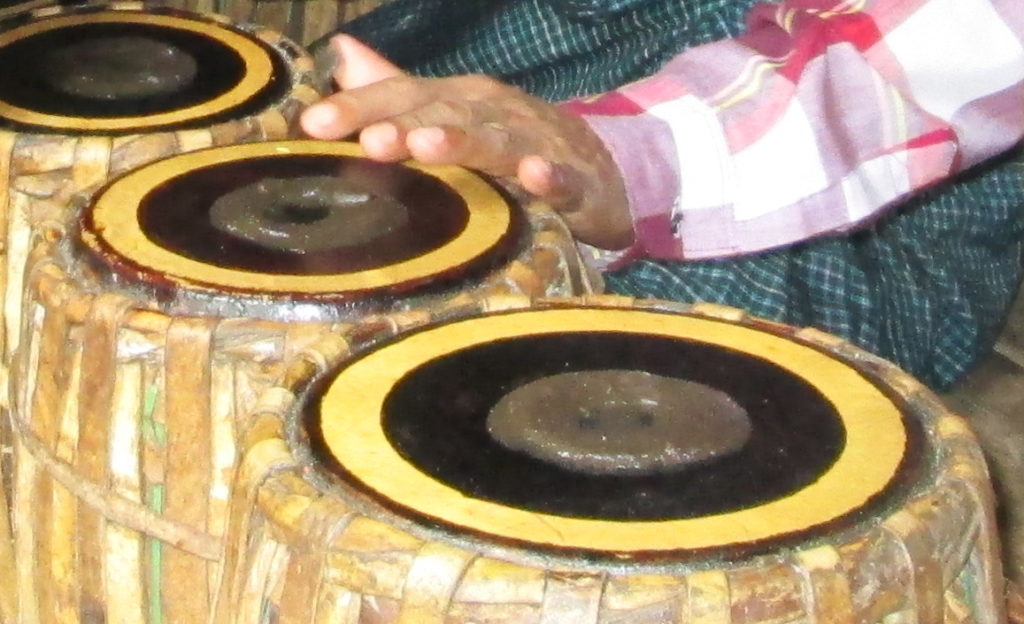
Fig. 1.1 Detail of the pat sa, the paste applied to the drum skin to correctly tune it. Yangon, 2013.
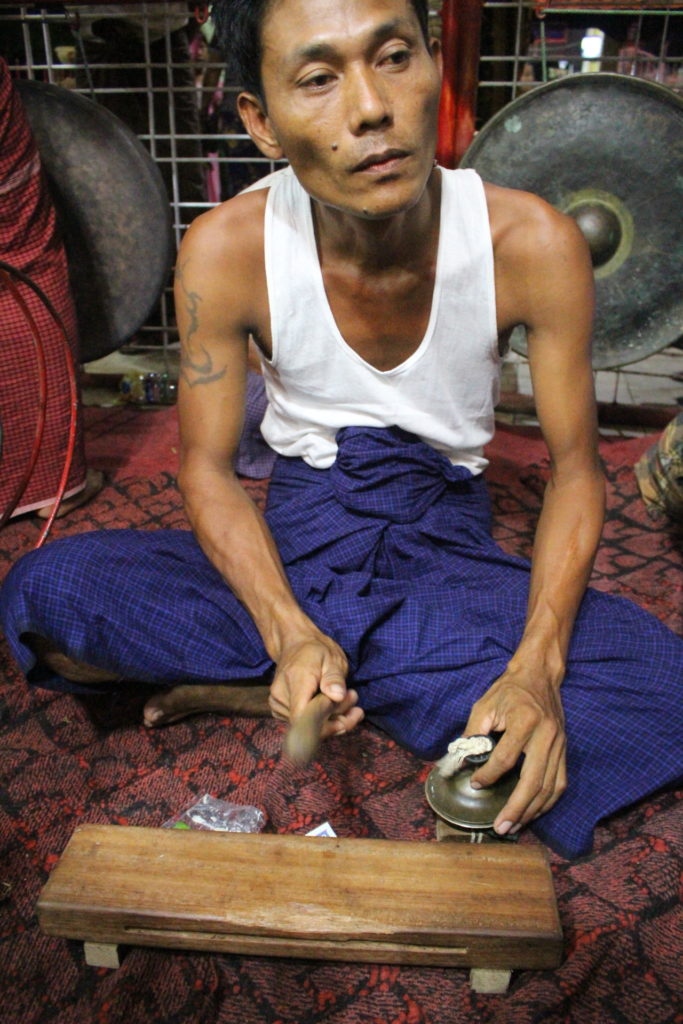
Fig. 1.2 A musician playing the si (small cymbals) and wa (wooden bar) idiophones. Taungbyone village, 2018.
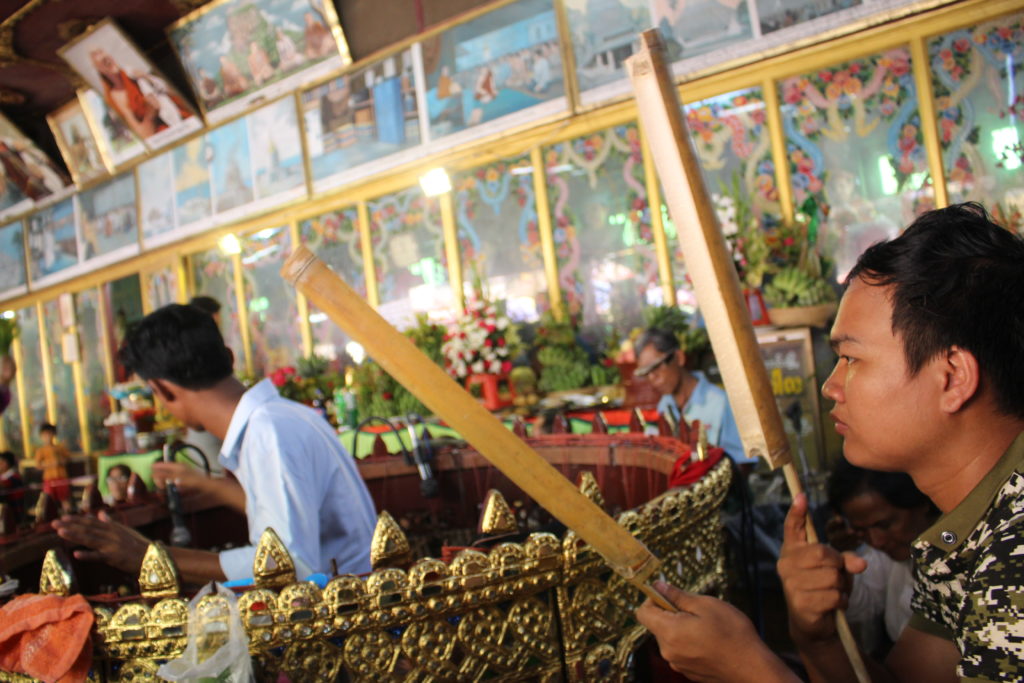
Fig. 1.3 The walethkout, an idiophone made from a bamboo cane, sometimes substitutes the wa woodblock. Kyi Lin Bo ensemble, Popa Village, 2017.
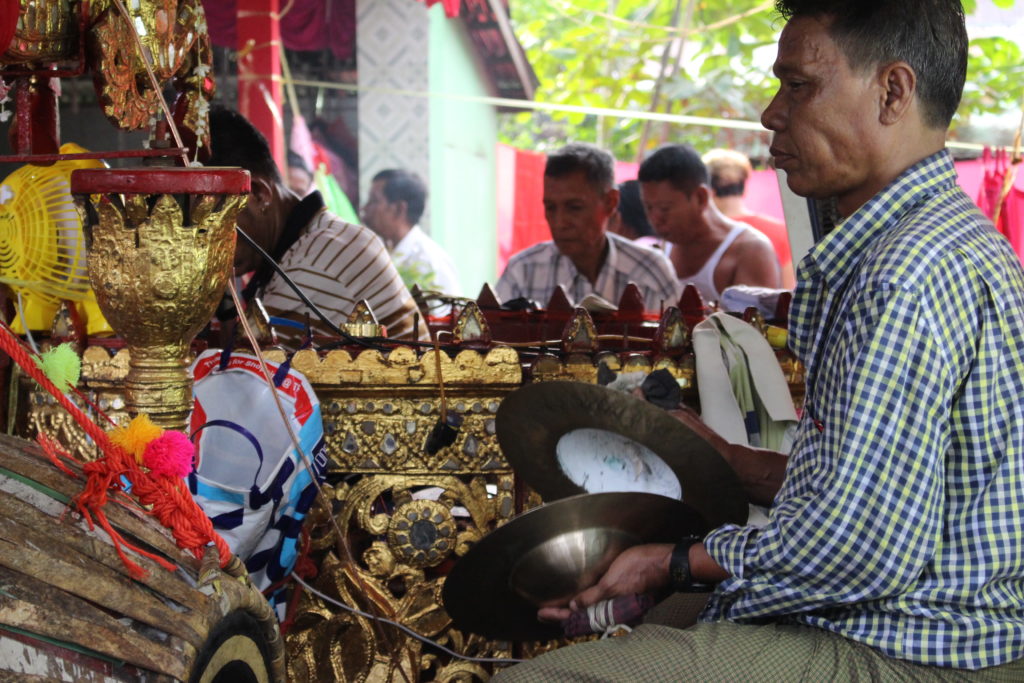
Fig. 1.4 The linkwin large cymbals give a particularly intense sound to the music performance. Yangon, 2017.

Fig. 1.5 Placed in the middle of the ensemble, the pat waing drum circle leads the other musicians during the performance of music and dances. Kyi Lin Bo ensemble, Popa Village, 2017.
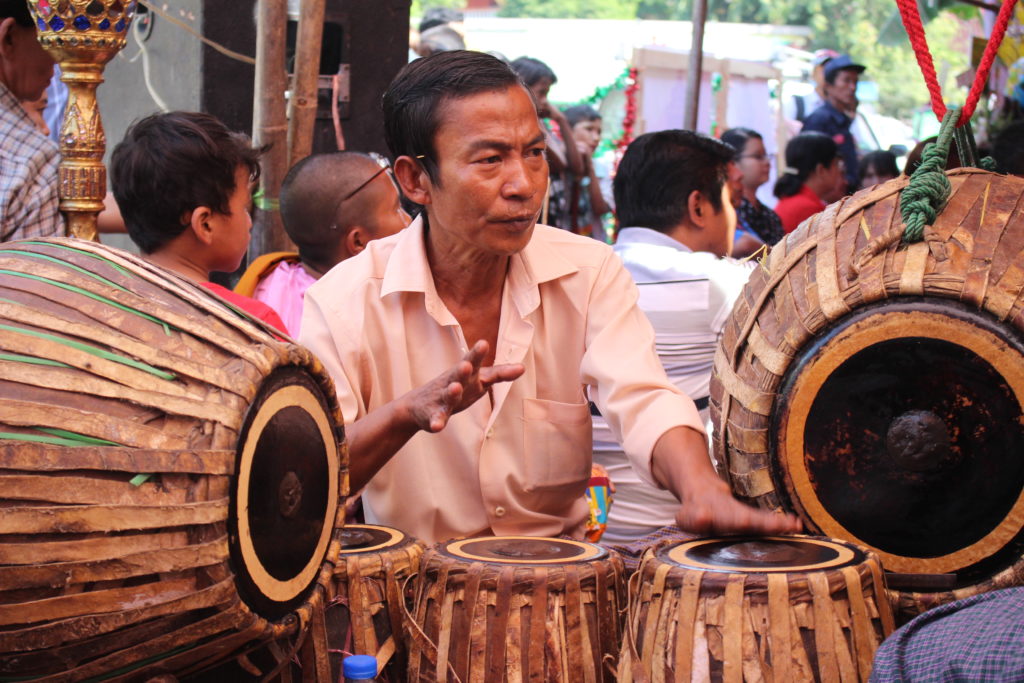
Fig. 1.6 A musician playing the drum set composed of the sahkunt (left), the six drum chauk lon pat (centre) and the large suspended drum pat ma (right). Kyi Lin Bo ensemble, Yangon, 2017.
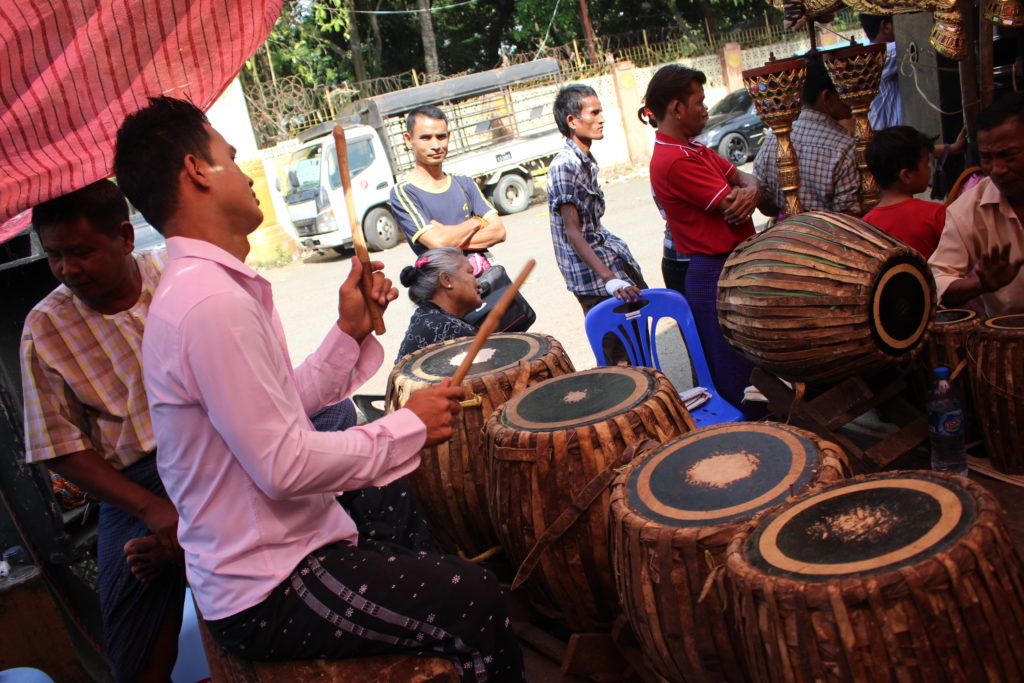
Fig. 1.7 A musician playing the sito large barrel drums, hitting the skins with drum sticks. Kyi Lin Bo ensemble, Yangon, 2017.
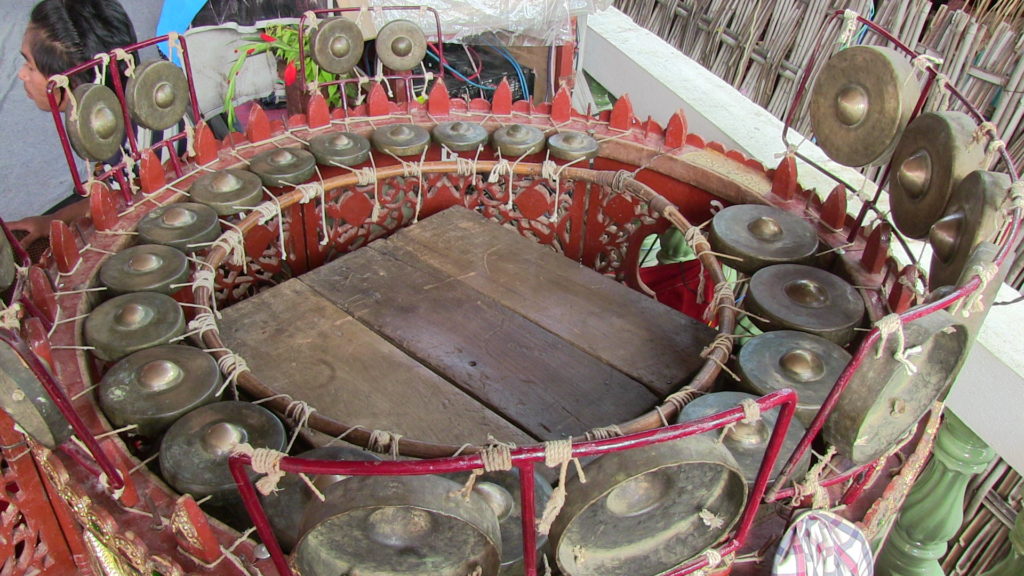
Fig. 1.8 The kyi waing gong circle. The vertically suspended gongs are a relatively recent innovation; they allow the musician to perform more melodic variations. Taungbyone village, 2013.

Fig. 1.9 The maung hsaing gong-chime provides melodic support to the gong circle; like the latter, it is played with two mallets. Bo Naing ensemble, Mandalay, 2018.
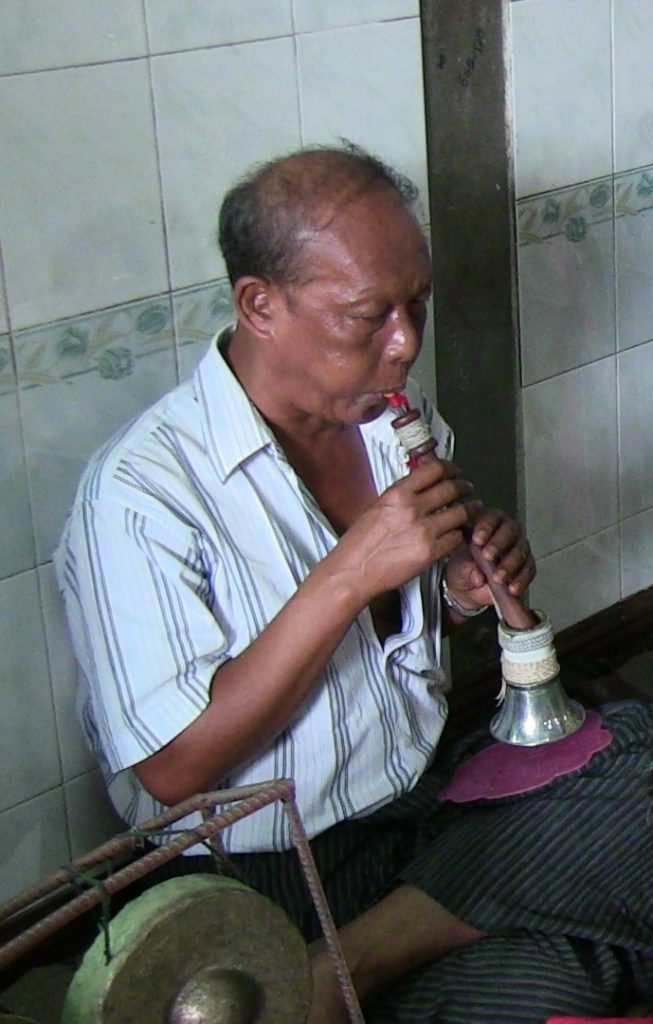
Fig. 1.10 The shawm master U Ohn Htay playing fast and complex melodies. Kyi Lin Bo ensemble, Yangon, 2013.
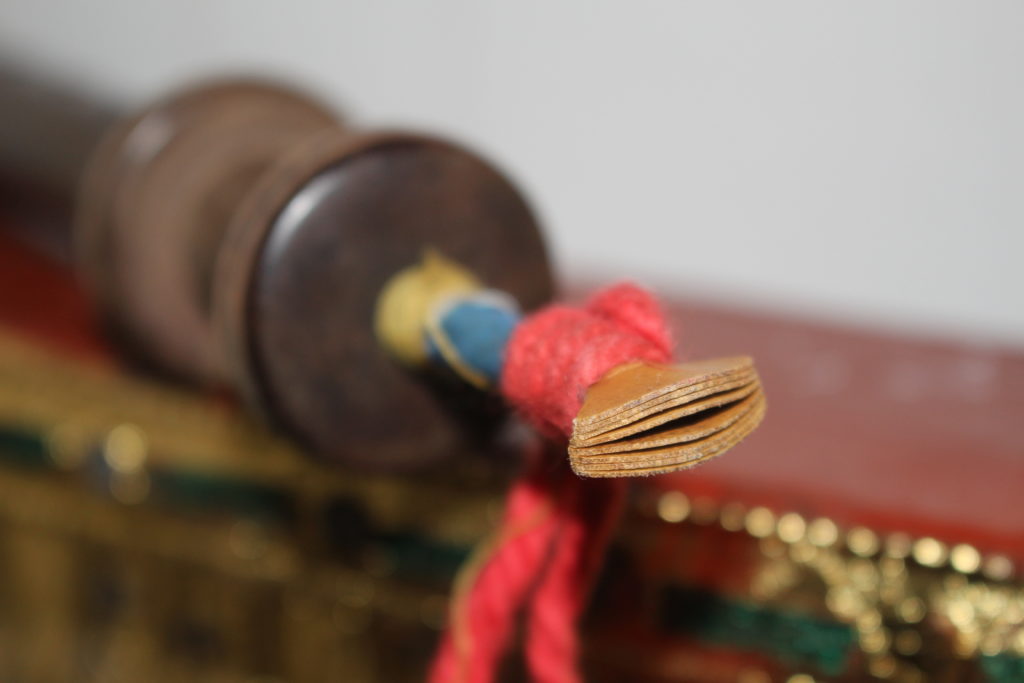
Fig. 1.11 Detail of the hne shawm multiple-reed.
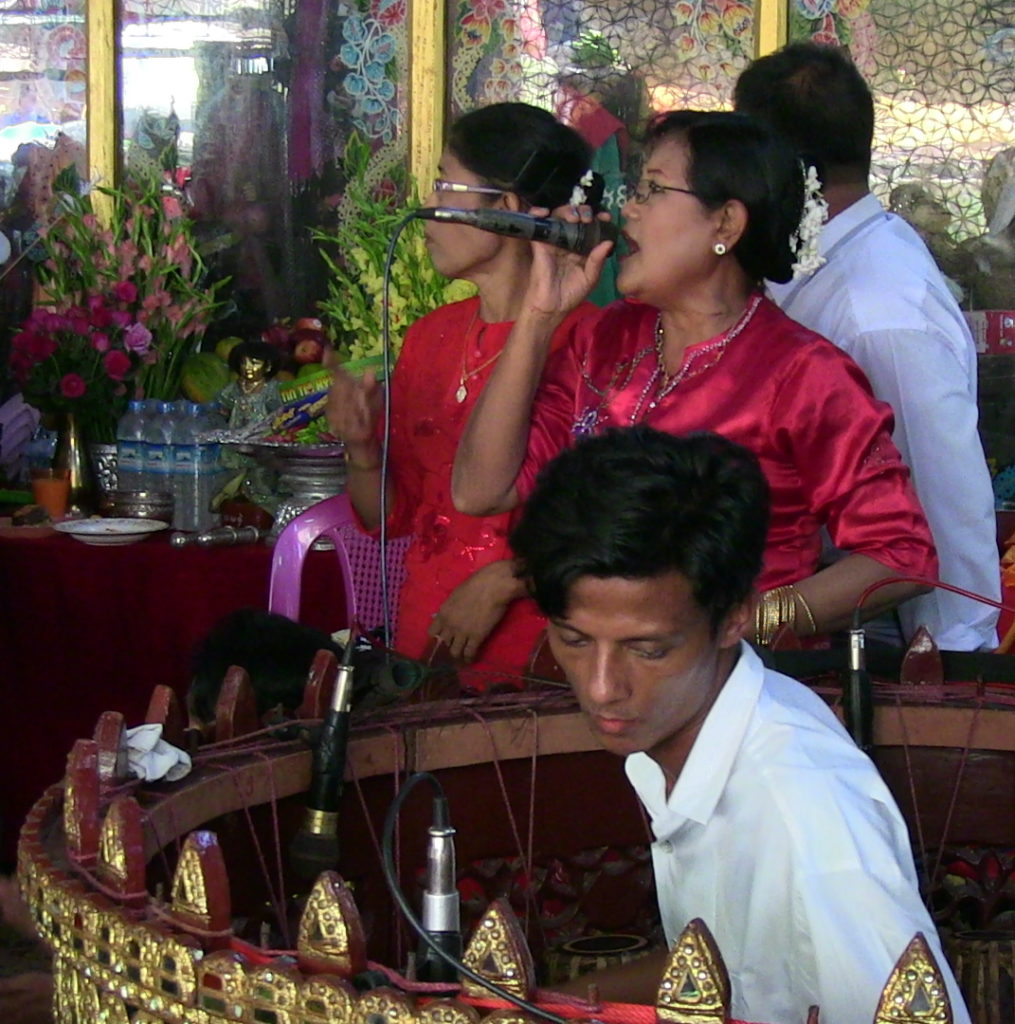
Fig. 1.12 The singers take position in front of the ensemble, alternating throughout the performance. In the picture, holding the microphone, the singer Ma Than Dar. Kyi Lin Bo ensemble,Popa village, 2013.
The hsaing waing ensemble
In Burma (Myanmar), the traditional hsaing waing ensemble has a fundamental role in the celebration of private and public ceremonies. Featuring from six to ten musicians, as in other South East Asian cultures the ensemble is characterised by tuned-percussion instruments (drums and gong chimes), accompanied by idiophones (cymbals and bamboo), aerophones (shawm) and singers.
The sound of the hsaing waing accompanies different kinds of performance: entertainment, as dance and theatre shows (zat pwe and anyeint pwe), or religious, like those related to Buddhist ceremonies (ahlu pwe) and the spirit cult (nat pwe). A hsaing waing ensemble performing theatre music is called zat hsaing; ahlu hsaing if it performs in a Buddhist donation ceremony and nat hsaing in a spirit possession ceremony.
In all these contexts, the instruments are essentially the same. Conversely, the hsaing style and repertoire change according to the performance context. For example, the ahlu hsaing and zat hsaing are characterised by a highly ornamented style – especially with regard to the pat waing drum circle – and a cultured repertoire. On the other hand, the nat hsaing ensemble has a less ornamented performing style and fast tempos. This is the result of strict metric and rhythmic interlocking techniques used particularly by the drums, which play a prominent role.
Drum-chime instruments are a unique feature of Burmese musical culture. The drums are tuned by applying the right amount of a tuning paste (once made of ashes and rice or wax, today substituted by industrial products) called pat sa (literally “drum food”). The musician tunes the instrument by spreading the correct amount of pat sa on each drum skin. A larger quantity of pat sa will make the drum sound deeper (fig. 1.1). A similar paste is used to tune gongs and xylophones in other South East Asian countries.
In the hsaing waing ensemble, metre, rhythm and melody are one. The idiophones guide the performance of the whole ensemble, providing the others with important musical references. The shawm and the gong circle perform complex and intricate melodies, sometimes supported by the drum circle. In the nat hsaing, the loud sound of the drums provides the energy needed to support the mediums’ spirit possession dances. Although their role remains primarily rhythmic, the percussion instruments are tuned: so their role is never disconnected from the melody.
Si and Wa (percussive idiophones)
The si (small cymbals) and wa (woodblocks) idiophones are considered as one instrument (sinewa). In Burmese their names indicate the materials they are made of – bronze and bamboo (fig. 1.2).
The si consists of two small cymbals: the lower one is often fixed to a woodblock, allowing the musician to play it with one hand; with the other he plays the wa, a bamboo stick used to strike a pierced wooden lath. Occasionally the wa is substituted by a walethkout. This is a piece of bamboo cane cut longitudinally for most of its length (about one meter) (fig. 1.3). The musician holds the instrument with both hands, clapping the two halves of the bamboo together. Rubber bands are usually mounted on the lower part of the bamboo where it is held: this allows the musician to play it with one hand, though less accurately. The clapping sound of the walethkout is intense, making it particularly suitable for accompanying dances.
Linkwin (large cymbals)
The linkwin (also yakwin) large cymbals are played by one musician, who holds one cymbal in each hand by an upper grip; using different techniques, the musician makes the two cymbals clash to produce different kinds of sound (fig. 1.4).
In general, the sound of the linkwin is very intense. The role of these cymbals is ambivalent in nat hsaing music. Playing to the beat marked by the drums, the sound of the cymbals stands out from the lower frequencies of the larger drums, making the performance more incisive. When the linkwin play on the secondary beats, they provide an “up-tempo” that helps confer dynamism to the ensemble performance; this last case is particularly suitable for supporting spirit possession dances.
Pat waing (drum circle)
The pat waing drum circle (from pat, “drum”, and waing “circle”) is composed of 21 tuned drums arranged in series from the largest to the smallest. The drums are suspended from a circular wooden frame, richly decorated with gilded stuccoes and coloured glass. The player sits inside the frame, completely surrounded and partly hidden by it; only the upper part of his torso is visible from outside (fig. 1.5).
The drum skins are tuned using the right amount of pat sa. The player beats the larger drums with the palms of his hands and the smaller one with his fingers, and must twist his torso 180-degrees to play them.
To enter the wooden frame, the musician must lower his head and go through a small door, called the “king’s entrance” (min bauk). This gesture is highly symbolical, as by going through the door the musician was forced to bow in front of the members of the royal court before starting to play. Before the collapse of the Burmese monarchy due to the British conquest (in the late 19th century), the pat waing and the hsaing ensemble provided the typical musical entertainment in the Burmese royal palace.
In the court repertoires, the musical idiom of this instrument is characterised by a highly virtuoso style. This is almost completely absent in the nat hsaing style, where the drum circle supports the possession dances. The musician plays the drums in the medium and lower register, performing and constructing metric-rhythmic cycles with the rest of the ensemble. These cycles identify and call on different spirits, allowing them to manifest themselves in the bodies of the mediums.
The drum circle is the main instrument of the hsaing waing ensemble. It leads the rest of the ensemble during the performance, indicating song section changes with a series of musical signals. For this reason, the drum circle player must pay particular attention to the development of the ritual.
Pat ma (suspended drum) and chauk lon pat (tuned drums)
The pat ma and the chauk lon pat are one set of tuned drums, played by one musician (sometimes, a third short drum, the sahkunt, is also included) (Fig. 1.6).
The pat ma is a double-skinned barrel drum and the largest in the ensemble. It is suspended with ropes from a richly decorated structure representing a mythical animal (the pyinsa rupa); however, it is not unusual to see it supported by a wooden or bamboo frame.
The musician beats the drum skins with both hands. The tuning is adjusted by applying the right amount of pat sa, like the other drums of the ensemble. The left drum skin is normally larger and produces a lower sound; the right one is smaller and gives a higher sound.
Given its deep, powerful sound, the pat ma can usually be seen interacting with the dancers: these, sometimes in a state of possession, can create visual or even physical contact with the pat ma; in communicating with the musician, they ask for greater sonic intensity.
The chauk lon pat consists of six small drums, tuned by spreading pat sa on the upper skin. They are positioned to the right of the pat ma drum, from low to high register. In order to reach and comfortably play the instrument, the musician must twist his torso 45 degrees to the right. It is not uncommon to see the musician play the pat ma and the chauk lon pat with two different hands. Sometimes the sahkunt short drum is positioned longwise above the chauk lon pat on a wooden support.
The introduction of this set seems to be a relatively recent acquisition in the hsaing waing: the chauk lon pat became popular only in the 1920s-30s.
Use of the chauk lon pat is fairly limited in the nat hsaing practice. The instrument provides support to the pat waing drum circle, playing in correspondence with it and reinforcing its sonic impact. The chauk lon pat also gives the musician the chance to perform melodic variations within the metric-rhythmic cycles.
Sito (barrel drums)
The sito is a drum set consisting of two, three or four barrel drums. The drums are arranged from the larger to the smaller from left to right; they sit vertically on the ground and are hit on one side only with drumsticks. This playing technique is unique in the hsaing waing ensemble and provides an intense sound. The sito is thus a crucial instrument in the nat hsaing ensemble (fig. 1.7).
Unlike the other drums of the ensemble, the sito’s drum skins are not tuned. A lower or higher register sound depends on the size of the drum itself. Because of this, the sito plays only a rhythmic supporting and reinforcing role: it usually plays in time with the beats marked by the si and wa idiophones – thus also by the pat ma drum. The lower sounding drum usually plays to the primary beat marked by the wa at the end of a metric-rhythmic cycle.
Kyi waing and maung hsaing (gong circle and gong-chime)
The kyi waing and maung hsaing are the only melodic and percussive instruments in the ensemble (excluding the drum circle). They are placed next to the other, usually to the right of the drum circle. These gong instruments play fast, complex and ornamented melodic variations together (fig. 1.8).
The kyi waing (from kyi, “bronze” and waing “circle”) is a circle of 21 bossed, tuned gongs. Each gong is suspended from the frame by strings tied through special holes. The wooden frame is sometimes decorated like the pat waing frame with paint; or may be just a simple iron structure. The musician sits in the middle of the frame, hitting the gongs with mallets with a wooden grip and padded end. As for the drum circle, the musician must twist his torso almost 180-degrees to reach all the gongs during the performance.
Unlike the drums of the ensemble, the kyi waing gong circle’s tuning is fixed, so it is today used as a reference for tuning the other drums before the beginning of each performance.
The maung hsaing (from maung, “gong” and hsaing “suspended”) is a square gong-chime made up of a variable number of bossed gongs (about 18) that are normally tuned to a lower register than the kyi waing gong circle (fig. 1.9).
The instrument is not always included in the ensemble – particularly in the case of the nat hsaing ensemble, for which it is not considered strictly necessary. Indeed, the maung hsaing usually repeats the melody of the kyi waing gong circle with minimal variations.
Hne (shawm)
The hne is the only wind instrument in the hsaing waing ensemble. There are two types: the hne gyi (large hne) and the hne nge (small hne), which usually alternate throughout the performance, depending on the piece. The deep, dark sound of the large hne is particularly suited to accompanying slow, solemn pieces; the agile structure of the small hne allows the musician to perform fast and complex melodies, making it the preferred choice in the nat hsaing (fig. 1.10).
The hne is a multiple-reed aerophone (fig. 1.11). The reed is made by skilfully folding and cutting a sheet of bamboo fibre several times. The reed is made to vibrate using a circular-breathing technique, which allows the musician to obtain long and constant sounds without the need to catch his breath.
The musician keeps the reed between his lips and, by adjusting the degree of pressure and air emission, is able to produce fast melodic changes, also obtaining micro-tonal variations (i.e., sounds that are inserted between the various degrees of a musical scale).
Combined with the circular-breathing technique, this characteristic allows the musician to employ several performing techniques. A style characterised by long slurred notes can immediately and seamlessly be changed into one with fast, staccato notes and fast register changes.
Singers
The vocal part usually plays an important role in the nat hsaing ensemble. Although the role of the singer (ahsodaw) is generally considered a female one, it is not rare to see men or even the mediums themselves taking on one or more vocal parts. However, as the mediums are engaged in the dance, they often restrict themselves to invoking the spirits, which takes place before the performance of a song. The vocal part of the song itself is performed by professional singers and occasionally by the musicians (fig. 1.12). During the instrumental section of a song, the vocal part presents only shouts of incitement; these highlight the most intense moments of the dancing or the musical performance.
